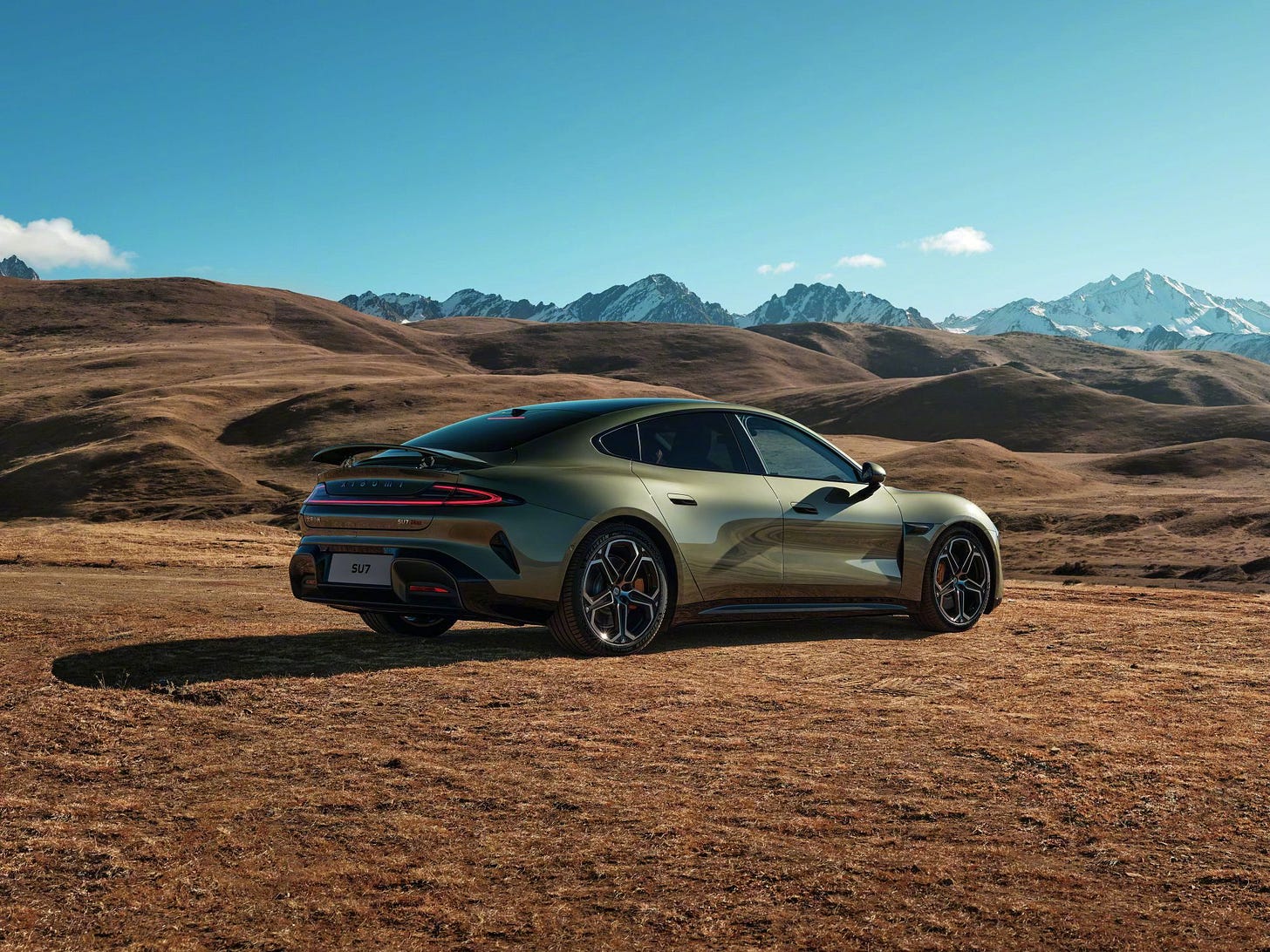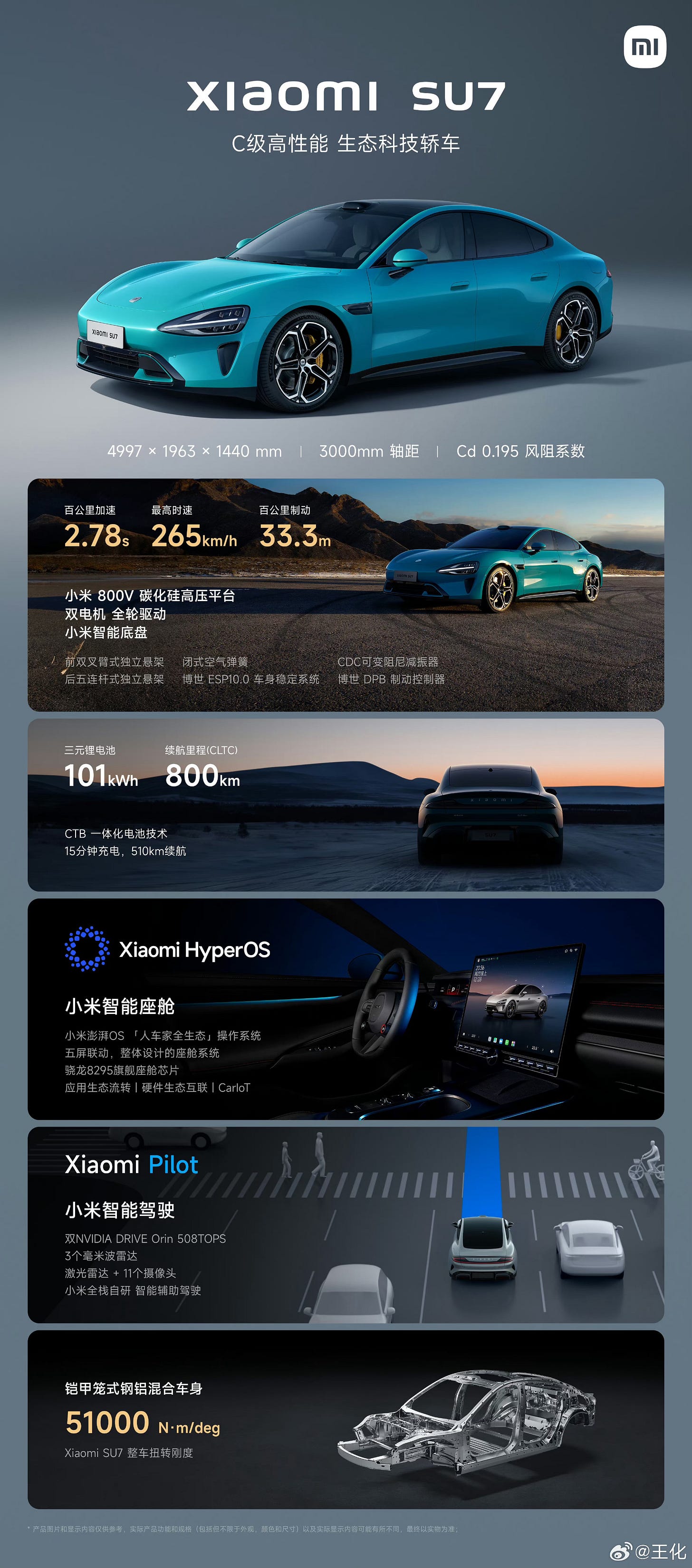Everything you want to know about Xiaomi cars is right here
Over 1000 days after announcing its car-making venture, Xiaomi's automobile has finally debuted.
On December 28, 2023, Xiaomi held a technology conference for its automobile, showcasing a dazzling array of technical innovations that left many impressed.
Lei Jun, the Chairman of Xiaomi Group, unveiled a suite of technologies, such as the CTB integrated battery technology, boasting the world's highest volumetric efficiency at 77.8%. The vehicle utilizes Xiaomi's 800V silicon carbide high-voltage platform, with a maximum voltage of 871V.
Lei Jun explained that the Xiaomi battery meets the world's strictest thermal runaway safety standards, featuring 17 layers of high-voltage insulation protection and the largest cooling area in its class at 7.8m², employing 165 aerogel thermal insulation sheets.
Additionally, the industry-first cell inversion technology is used to ensure maximum safety for the passenger cabin. Lei Jun declared that Xiaomi's automobile aspires to be the king of electric vehicle endurance in winter.
Regrettably, Lei Jun did not reveal the price of the Xiaomi car at this technology conference. However, this did not diminish the small shockwave Lei Jun brought to the new energy industry with this launch.
Before unveiling the Xiaomi car, Lei Jun had disclosed that the first model involved the efforts of 3,400 engineers and a research and development cost exceeding 10 billion yuan, representing an industry-unprecedented investment over ten times the norm. Considering the specific performance parameters, the high-investment Xiaomi car is indeed highly competitive.
For example, the high-end version of the Xiaomi car supports 800V charging, has a high battery capacity of 101 kWh, and is equipped with dual motors, with the front and rear motors delivering 220 kW and 275 kW of power, respectively.
Despite the impressive technical prowess of the Xiaomi car, it may be challenging to replicate the explosive market success that the first generation of Xiaomi smartphones achieved upon their launch.
In recent years, as many new and old forces have intensified their efforts in the sector, the new energy vehicle industry has become highly competitive, leaving little room for Xiaomi car to establish a distinct competitive advantage. Particularly considering that Xiaomi car has not yet achieved economies of scale, it would be difficult to continuously engage in a "price war," making it challenging to convince consumers to make a purchase.
Combining the information from Xiaomi's technology conference and the disclosures from the Ministry of Industry and Information Technology, the dimensions of the Xiaomi car are 4997mm x 1963mm x 1440mm, with a wheelbase of 3000mm. It is positioned as a C-class vehicle, placing it in the same category as the Zhijie S7, NIO ET7, and BYD Seal.
Xiaomi car will be available in two versions: a standard and a high-end model. The standard model, SU7, will have a total vehicle voltage of 400V, equipped with a 73.6 kWh BYD battery, and its range will be 628km and 668km for different variants. The high-end version, SU7 Pro/Max, will have a total vehicle voltage of 800V, equipped with a 101 kWh CATL battery, and its range will be 800km and 750km.
Even though Xiaomi has not disclosed the price of its cars, comparing with similar products in the industry and based on leaks from car bloggers, the price of Xiaomi cars may not be low.
For comparison, the price of products with similar configurations to the entry-level Xiaomi car, like the 2023 BYD Han EV Champion Edition and the 2022 Xpeng P7, is around 200,000 yuan. It is likely that the starting price of the Xiaomi SU7 will also be in this range.
Given that the high-end version of the Xiaomi car, the SU7 Pro/Max, is equipped with many powerful technologies, its price is expected to be higher.
Despite Lei Jun's claim that Xiaomi cars will be priced high with a 'justifiable reason', ensuring that the experience will exceed expectations, considering the current new energy vehicle market, the high-priced Xiaomi car might find it challenging to achieve immediate success.
Unlike typical personalized products, cars have a strong social attribute. The brand's tone directly influences the car's bargaining power. Although Xiaomi has been targeting the high-end market for many years with its smartphones, it appears that its journey towards becoming a high-end brand has not been as successful as anticipated.
The data released by the China Association of Automobile Manufacturers shows that the growth rate of new energy vehicle sales in China was 159.8% in 2021, 93.4% in 2022, and 44.1% in the first half of 2023, indicating a clear downward trend.
Due to the slowdown in market growth, many automakers have reduced product prices since 2023 to increase sales volume. For example, at the beginning of 2023, Tesla reduced the prices of the Model 3 and Model Y by 20,000 to 48,000 yuan. In December, BYD, Lixiang (Leapmotor), and FAW Toyota also initiated promotional sales.
In light of the future direction of the new energy vehicle market, Yu Chengdong, CEO of Huawei's Smart Car Solutions BU, stated, "The competition that everyone sees is just beginning, and it will intensify in the future. The reshuffling of the car market will be very fierce, and the market competition will be very intense."
This is not good news for Xiaomi cars, which are still in the capacity ramp-up phase and have not yet achieved economies of scale. As market competition intensifies, other automakers that have already achieved scale may choose to lower their prices, which could put significant pressure on Xiaomi cars.







